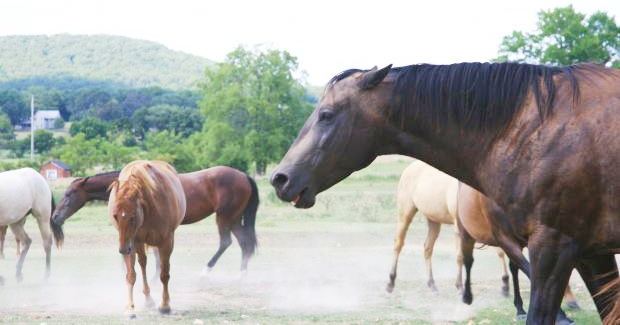 Horses are funny animals. If I had a chance to sit out there in the corral all day and watch them, I would. I have five horses right now, and they are each so different, it is so interesting to see how they act and respond to each other. I believe in animal behaviouralist’s technical terms, this would be called herd dynamics.
Horses are funny animals. If I had a chance to sit out there in the corral all day and watch them, I would. I have five horses right now, and they are each so different, it is so interesting to see how they act and respond to each other. I believe in animal behaviouralist’s technical terms, this would be called herd dynamics.
I was horseless when I first met my husband, and we had only been dating a few months when he suggested that I buy a horse and keep it at his parent’s farm. That’s when I knew our relationship was “serious” and definitely headed in the right direction! So we went to look at a bay mare at a neighbor’s place that we saw advertised on a horse classifieds website. When we looked at her, we discovered she was club-footed and only fit for a broodmare. Since we wanted a horse with potential as a riding horse, we asked the owner if he had any other horses for sale. He said, “Sure, everything’s got a price tag.” I picked a really nicely-built mare out of his herd, a four year old sorrel with foundation Quarter Horse bloodlines. We named her Daisy.
I bartered the guy down a couple hundred on Daisy’s purchase price by agreeing to take another gelding of his to train. So a bay gelding named Joe accompanied Daisy to the farm for a couple of months. Having Joe around kept Daisy happy, but also helped her get used to being alone more, because I rode him quite a bit and left her at the barn by herself. As soon as Joe went back to his owner though, Daisy was pretty lonely.
So that winter, Cowboy Dad and I went to a horse auction. And sure enough, we came home with a fuzzy little starved-looking wild Appaloosa weanling named Milo. I remember unloading Milo out of the back of the trailer….he wasn’t halterbroke, but he was so small it didn’t matter, you could just pull him around where you wanted him. We put him in a pen adjacent to Daisy, thinking that we didn’t want her biting him or chasing him through the fence, and that we should give them time to get acquainted before putting them together. We needn’t have worried—Daisy accepted Milo as her very own foal! She has never foaled, but those mothering instincts came out very strong when she met Milo. They have been inseparable ever since.
A year or so later we bought Cricket, our oldest horse, as a starter horse for my husband. She has been our smartest purchase yet, as just about anyone can ride her. But she is timid, and is no match for Daisy’s authority, and even Milo tries to boss her around, though Cricket is higher on the totem pole than he is. So if there’s grain involved, Daisy chooses her feed pan, and drives Cricket away, but allows Milo to eat beside her from the same pan. Yet, if you let them out to graze, Milo goes off on his own, and Daisy and Cricket graze side by side, their noses within just a couple inches the whole time…you would think they were best friends! Also, if you ride one mare, the other mare will whinny and act up until you bring the other back. Milo is pretty much okay on his own, not much fussing involved. The three of them have gotten along very well for the many years that we’ve owned them.
Well, last fall we took in two black geldings, Genesis and Toby, from my brother. We kept them separate for quite awhile, just letting them out to graze together at short intervals. It was evident even across the fence that Daisy was going to keep her place as lead mare. She would pin her ears at them and drive at them, and they had no choice but to retreat. We were curious how they were going to adjust to a being a herd of five.
It seems that if a horse has been the underdog for awhile, he builds up more antagonism against weaker horses. And that’s what I’ve seen in the two black geldings. Genesis has always been dominant over Toby, but he gave in to Daisy’s leadership when they joined our herd. They both rule over Cricket and Milo, but Toby especially seems to take out his wrath on Cricket, chasing her far away at feeding times. I feel sorry for her, but usually just make sure that the feed pans are spread out enough that she can find her own place to eat without being bothered too much.
What’s really interesting to me is Milo’s crafty little ways. He is the dead last horse in the pecking order. But because of Daisy’s benevolence, he may as well be top dog. He has figured out that if he is close beside Daisy, the other horses don’t dare bother him. So he sticks to Daisy like glue. They could be eating grain from their five different feed pans, and no one threatening to chase him, but if Daisy decides to walk over to an unoccupied feed pan, Milo does not stay at his own feed pan, but literally scurries along after her. He does not dare to be away from her, even for a minute.
Milo doesn’t stop there, though. He is constantly mouthing off at the other geldings. If one of the black ones walks by or even looks in his direction while they’re eating their hay, Milo will swing his head at them with his ears pinned, or stomp his heels and swish his tail. They tolerate it, because he is close by Daisy’s side. Daisy does not act overly aggressive to any of the other horses, but Milo thinks he has something to prove, so he is always kicking or snapping at them, while hiding behind Daisy.
My husband thinks that we would not dare take Daisy out of the equation, or the whole balance of their system would be upset, and the black geldings would really pick on Milo. But I think maybe that Milo would adjust quite a bit and act more submissive without Daisy to protect him, and they would all get along just fine. Putting mares in with geldings always heightens their fussiness, and I think the geldings would even out their differences if the mares weren’t there.
Horse behavior is something I have wanted to learn more about, and I am constantly puzzled by what my horses choose to do when they are at freedom. In training horses, I firmly believe in letting a horse choose the correct action, by becoming the dominant member of a team to encourage the horse in the desired behavior. Learning their instincts and interactions within the herd helps me know horses better and learn to train them more effectively.

